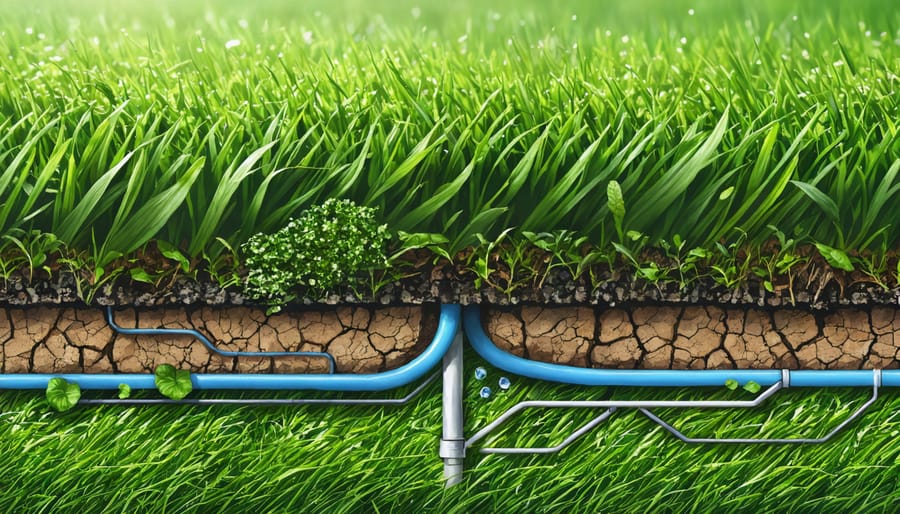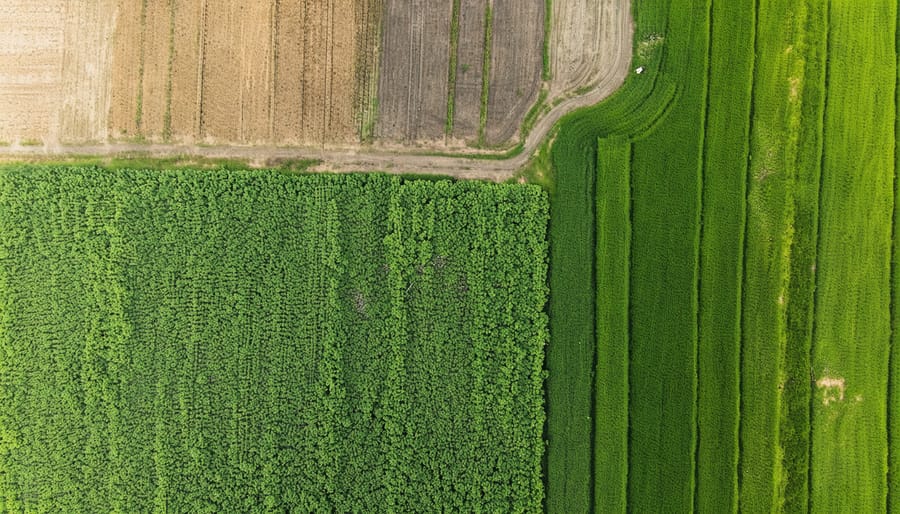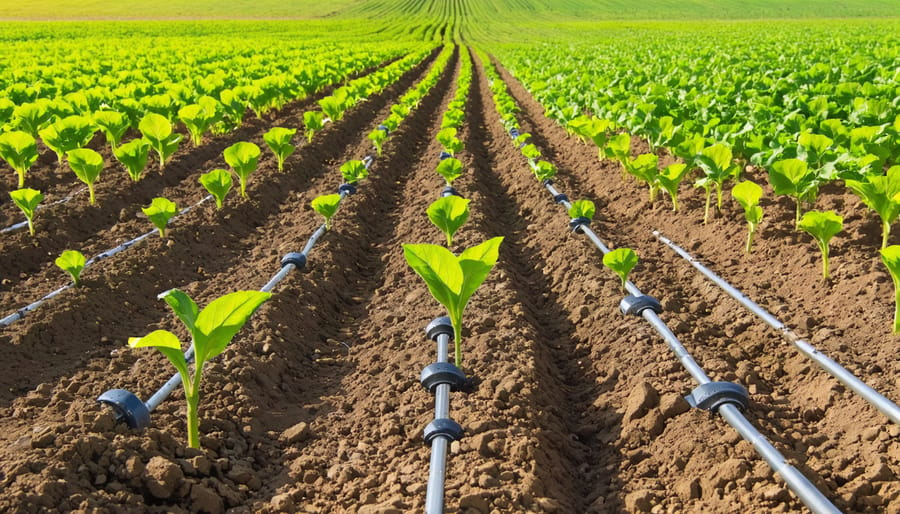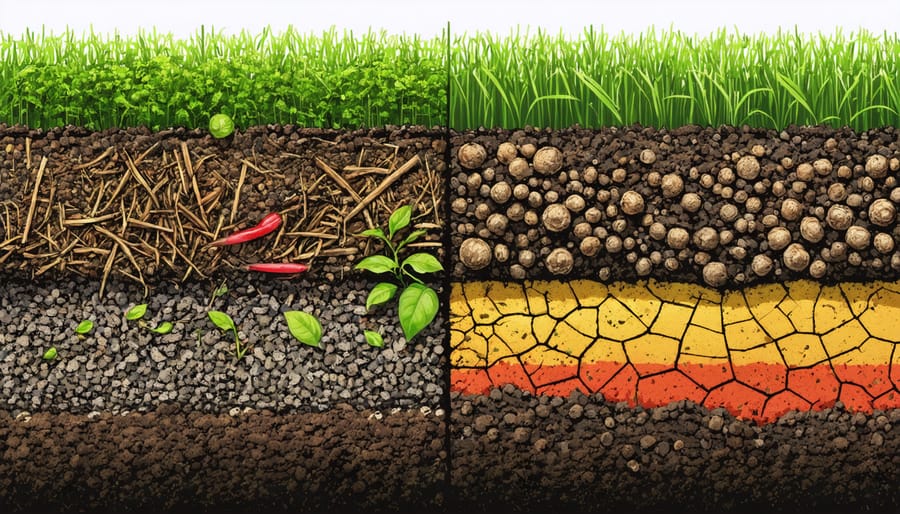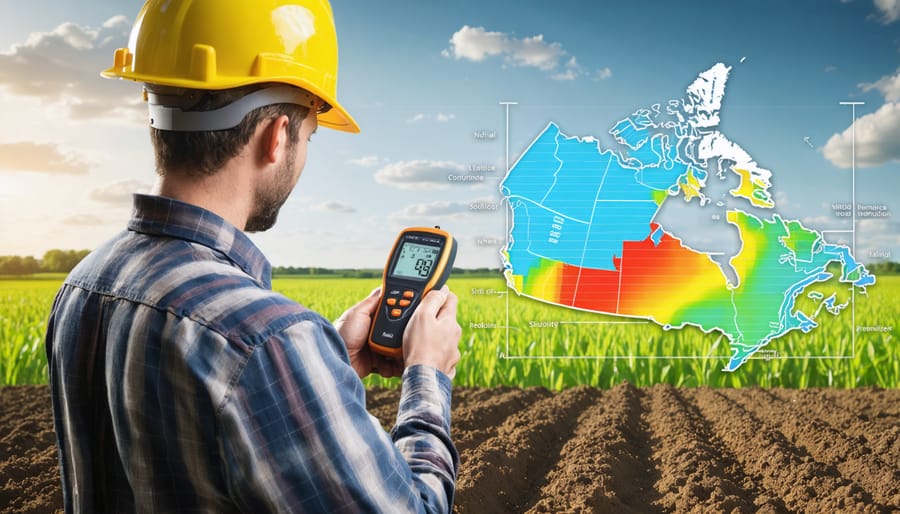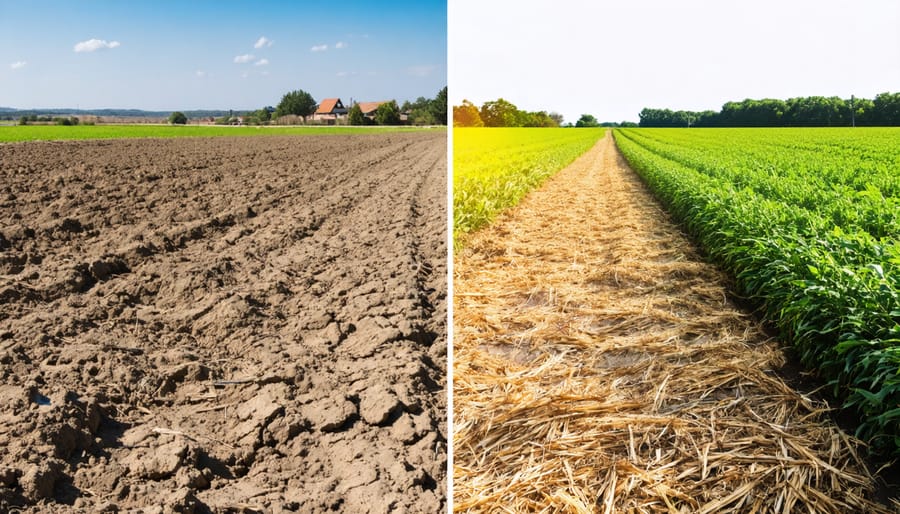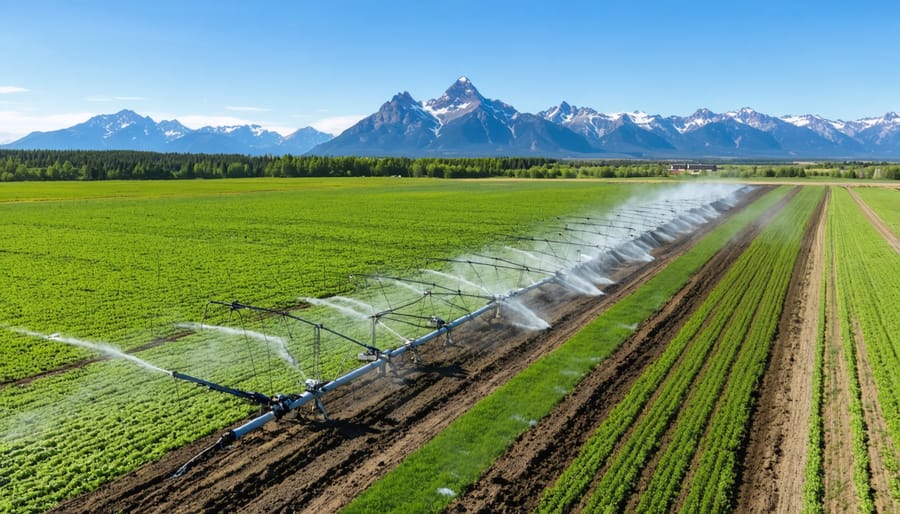Transform your lawn into a water-efficient oasis with subsurface irrigation – a cutting-edge system that delivers water directly to grass roots through underground tubing networks. In Alberta’s challenging climate, where water conservation meets agricultural innovation, subsurface irrigation reduces water usage by up to 60% compared to traditional sprinkler systems while promoting deeper, healthier root growth.
Prairie farmers and homeowners alike are discovering how this hidden irrigation method eliminates surface water loss through evaporation and prevents the common problems of overwatering and runoff. By maintaining consistent soil moisture levels 15-20 centimeters below the surface, subsurface systems create ideal growing conditions that discourage weed growth and fungal diseases while supporting robust turf development.
Experience shows that properly installed subsurface irrigation systems pay for themselves within 3-5 growing seasons through reduced water bills, lower maintenance requirements, and improved crop yields. As Canadian agriculture adapts to changing climate patterns, this precision watering approach represents a smart investment in sustainable lawn and field management that delivers measurable results year after year.
Why Alberta Farmers Are Switching to Subsurface Lawn Irrigation
Water Conservation in Our Prairie Climate
In our Prairie climate, where water scarcity and seasonal drought conditions are increasingly common, subsurface irrigation offers significant water conservation benefits. By delivering water directly to the root zone, these systems reduce evaporation losses that typically occur with traditional sprinkler systems. Studies conducted at the Lethbridge Research Centre show that subsurface irrigation can achieve water savings of up to 30% compared to conventional methods.
Our unique Prairie environment, with its hot summers and periodic dry spells, makes efficient water use crucial. Subsurface systems minimize surface runoff and wind drift, ensuring that nearly every drop serves its intended purpose. This precision is particularly valuable during water restriction periods, which have become more frequent across Alberta in recent years.
For lawn maintenance, these systems typically require only 2-3 deep watering sessions per week, compared to daily surface watering. This not only conserves water but also promotes deeper root growth, resulting in healthier, more drought-resistant turf. Many local farmers report maintaining lush lawns while using significantly less water throughout the growing season.
Cost Savings Over Traditional Systems
While subsurface irrigation systems typically require a higher initial investment compared to traditional sprinkler systems, the long-term savings are substantial. Alberta farmers report water usage reductions of 30-40% in the first year alone, with some operations saving up to 200,000 litres annually. These water savings translate directly to lower utility bills, with most systems paying for themselves within 3-5 years.
The reduced maintenance needs further contribute to cost efficiency. Traditional sprinkler systems often require seasonal repairs due to damage from lawn mowers, frost, or vandalism. In contrast, subsurface systems, protected underground, typically need maintenance only every 5-7 years. Labour costs decrease significantly as well, with automated systems reducing the time spent on irrigation management by up to 75%.
Energy costs are another area of savings, as subsurface systems operate at lower pressures than conventional sprinklers. A recent study from the University of Alberta showed that farms using subsurface irrigation reduced their pumping energy costs by an average of 25%. When combined with smart irrigation controllers, these systems can optimize water delivery based on soil moisture levels, further maximizing efficiency and reducing unnecessary water usage.
Setting Up Your Subsurface Irrigation System
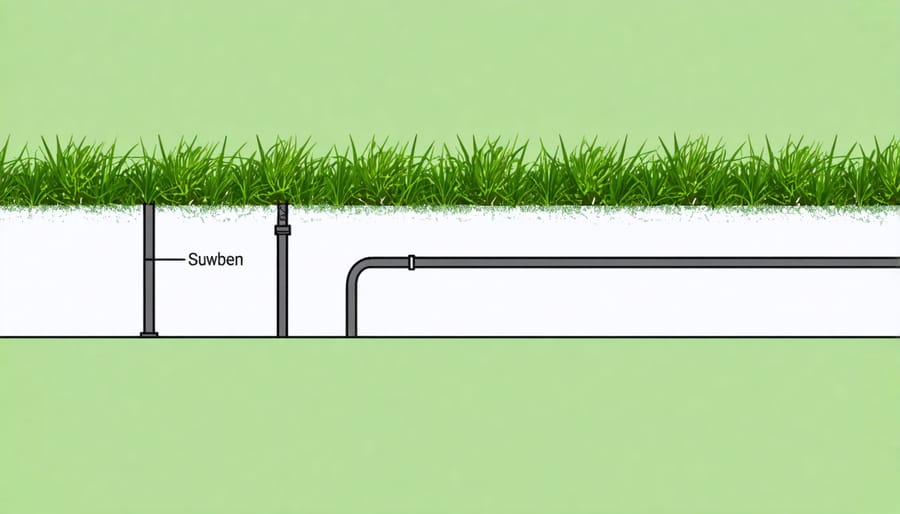
Design Planning for Alberta Soil Types
Effective subsurface irrigation design in Alberta requires careful attention to soil moisture management and local soil characteristics. Our province’s diverse soil types, from heavy clay in Edmonton to sandy loam in Medicine Hat, demand tailored approaches for optimal results.
Before installation, conduct a thorough soil analysis to determine texture, drainage patterns, and organic matter content. These soil type considerations directly influence emitter spacing, irrigation line depth, and water delivery rates.
For clay-rich soils common in central Alberta, space emitters further apart (45-60 cm) and position lines slightly shallower (15-20 cm deep) to account for slower lateral water movement. Sandy soils typical of southern regions require closer emitter spacing (30-45 cm) and deeper placement (20-25 cm) to prevent surface water loss.
Consider incorporating pressure-compensating emitters in areas with significant elevation changes, particularly in rolling prairie landscapes. For optimal results, divide your lawn into hydrozones based on soil uniformity, sun exposure, and slope variations.
Remember to factor in seasonal frost depth when determining installation depth – Alberta’s cold winters require placing lines below the frost line while maintaining effective root zone irrigation during the growing season.
Installation Best Practices
When installing subsurface irrigation in Alberta’s varied climate, proper depth placement is crucial. For most lawns, install irrigation lines 15 to 20 centimetres below the surface to protect against frost damage while maintaining optimal water distribution. In heavy clay soils, common in central Alberta, consider a slightly shallower depth of 12 to 15 centimetres for better water movement.
Begin by creating a detailed installation plan, mapping out irrigation zones based on your yard’s slope and soil conditions. Space irrigation lines 30 to 45 centimetres apart for even coverage, adjusting closer in sandy soils and wider in clay-based areas. When laying the lines, maintain a consistent 1% grade to ensure proper drainage during winter shutdown.
Install a high-quality filter system at the water source to prevent clogging, particularly important with our mineral-rich groundwater. Include automatic flush valves at the end of each zone – these are essential for winterization in our climate. Place air relief valves at the highest points of your system to prevent vacuum formation during shutdown.
For frost protection, ensure all above-ground components are properly insulated. In zones where frost penetrates deeply, consider adding extra depth to main supply lines. Install depth indicators at key points in your yard to help locate lines for future maintenance.
Remember to document your installation with photos and detailed drawings – this will prove invaluable for future reference. Before backfilling, run a pressure test to check for leaks. Once installed, gradually introduce water to the system to prevent soil displacement and allow proper settling. This methodical approach ensures a robust system that can withstand our challenging climate while delivering efficient irrigation for years to come.
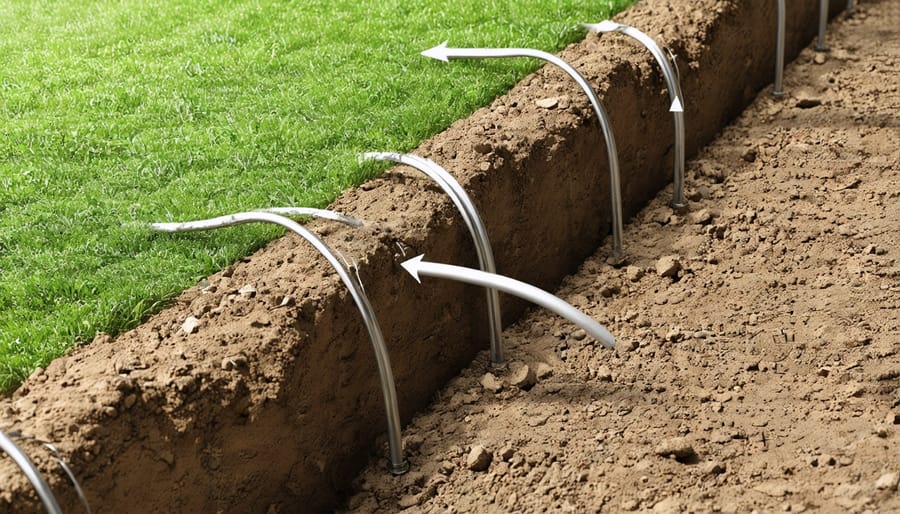
Winterization Requirements
In regions facing Alberta’s climate challenges, proper winterization of subsurface irrigation systems is crucial for long-term performance and system longevity. Begin the process in late fall, before the first hard freeze, by thoroughly draining all water lines using compressed air. Set the pressure between 30-40 PSI to avoid damaging the components while ensuring complete water removal.
Install automatic drain valves at system low points and consider adding insulation around exposed pipes and valve boxes. For added protection, inject food-grade antifreeze into the lines after draining, particularly in zones where complete drainage might be difficult due to terrain variations.
Mark all system components with high-visibility stakes before snowfall to prevent accidental damage during winter maintenance activities. Keep detailed records of your winterization process, including valve locations and drainage points, to streamline spring start-up procedures.
Remember to disconnect and safely store electronic controllers indoors, protecting them from freezing temperatures and moisture damage. Professional inspection before winter shutdown can identify potential issues and ensure your system is properly prepared for the cold season.
Maintenance and Troubleshooting
Seasonal Maintenance Schedule
To maintain your subsurface irrigation system throughout Alberta’s diverse seasons, follow this comprehensive maintenance schedule:
Spring (March-May):
– Inspect system components as snow melts
– Flush main lines and laterals to remove winter debris
– Check and clean filters
– Test system pressure and adjust as needed
– Verify all zones are functioning properly
– Inspect for winter damage and repair if necessary
Summer (June-August):
– Monthly filter cleaning
– Weekly pressure checks
– Inspect emitters for root intrusion
– Monitor soil moisture levels
– Adjust watering schedules based on rainfall
– Check for signs of surface wetness indicating leaks
Fall (September-November):
– Begin system winterization in early October
– Flush all lines thoroughly
– Remove end caps to drain water
– Blow out lines with compressed air
– Store removable components indoors
– Document any repairs needed for spring
Winter (December-February):
– Review system documentation
– Order replacement parts if needed
– Plan spring upgrades
– Maintain snow cover for natural insulation
– Monitor ground freeze depth
Year-round tasks:
– Keep detailed maintenance logs
– Check local weather forecasts
– Adjust irrigation schedules seasonally
– Monitor plant health indicators
– Schedule professional inspections annually
Remember that timing may vary depending on your specific location in Alberta and local weather patterns. Consulting with local irrigation specialists can help fine-tune this schedule for your particular system and conditions.
Common Issues and Solutions
While subsurface irrigation systems are reliable, you may encounter a few common challenges. Here’s how to address them effectively:
Root intrusion can sometimes block emitters, particularly with aggressive plant species. Installing systems with built-in root barriers or using copper-impregnated emitters has proven successful for many Alberta farmers. Regular system checks during spring maintenance can catch this early.
Soil compaction may affect water distribution in heavy clay soils common to parts of Alberta. The solution is incorporating organic matter during installation and maintaining proper soil structure through good cultivation practices. Consider installing pressure-compensating emitters to ensure even water distribution.
Freezing can be a concern in our climate. Ensure proper system drainage before winter sets in, typically by early October. Many successful installations include automatic drain valves at system low points.
Uneven watering patterns sometimes occur due to pressure irregularities. Installing pressure regulators and conducting regular pressure checks helps maintain consistent flow. Most systems should operate between 150-200 kPa for optimal performance.
For winter damage prevention, mark your system components clearly before snowfall. This helps avoid accidental damage during snow removal or early spring yard work. Keep a detailed map of your system layout for easy troubleshooting when needed.
If you notice dry spots, first check for clogged emitters or breaks in the lines. Most issues can be resolved with a thorough system flush or simple line repair.
Real Results: Alberta Success Stories
Case Study: Red Deer Golf Course
The Red Deer Golf Course’s transition to subsurface irrigation in 2019 stands as a shining example of successful implementation in Alberta’s challenging climate. Located just south of Red Deer, this 18-hole championship course faced significant challenges with water conservation and maintaining consistent turf quality across its 75 hectares of managed grass.
Course superintendent Mike Davidson implemented the subsurface system in phases, starting with the driving range and gradually expanding to fairways and rough areas. The system, installed at a depth of 15 centimetres, delivers water directly to the root zone through a network of specialized drip lines spaced 45 centimetres apart.
The results have been remarkable. Water usage decreased by 42% compared to their previous overhead sprinkler system, while turf quality improved significantly. The course maintained playability even during the severe drought conditions of summer 2021, when many neighbouring facilities struggled.
“The investment paid for itself faster than expected,” notes Davidson. “We’ve cut our water bills nearly in half, and our maintenance costs are down about 30% because we’re dealing with fewer fungal issues and more consistent growth patterns.”
The success at Red Deer Golf Course has inspired several other Alberta golf facilities to explore subsurface irrigation, demonstrating its viability in our province’s unique climate conditions. The course now regularly hosts educational tours for other turf management professionals interested in sustainable irrigation solutions.
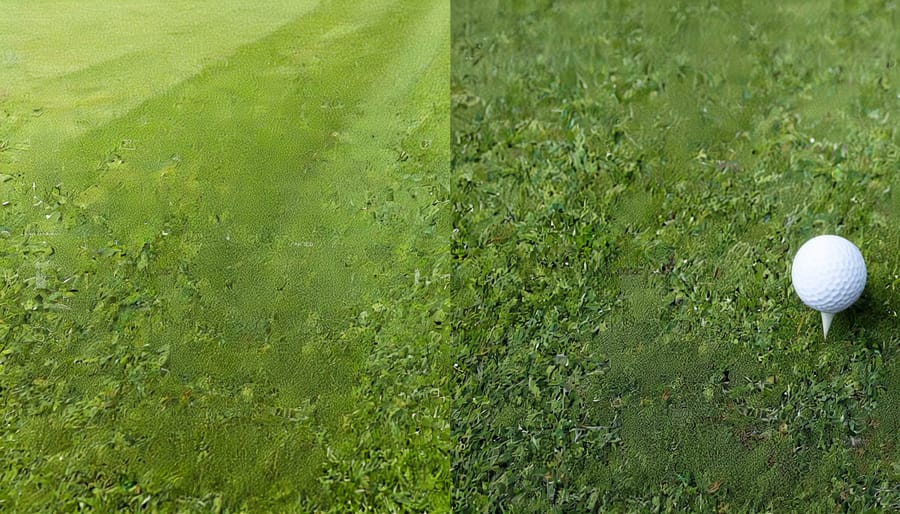
Small-Scale Success: Urban Farm Application
The McPherson family in Edmonton transformed their 500-square-metre urban property into a thriving market garden using subsurface irrigation, demonstrating the system’s effectiveness even in limited spaces. Sarah McPherson, a former office worker turned urban farmer, installed a drip-line network just 15 centimetres below the soil surface to maximize growing potential while maintaining water efficiency.
The installation, completed over a single weekend, required minimal disruption to existing garden beds. The McPhersons now grow an impressive variety of crops, including tomatoes, leafy greens, and root vegetables, producing enough to supply their family and contribute to local farmers’ markets throughout the growing season.
Their system uses 40% less water than traditional sprinkler irrigation, with moisture sensors helping maintain optimal soil conditions. The underground placement allows for year-round functionality, with lines staying protected during Alberta’s harsh winters. Most importantly, the system enables consistent crop production even during water restriction periods.
The success of their urban farm has inspired neighbouring properties to adopt similar systems. Sarah now hosts monthly workshops, sharing her experience with fellow urban farmers. “The key advantage is the ability to maintain consistent soil moisture without creating surface water competition between crops,” Sarah explains. Their property serves as a model for efficient small-scale agriculture, proving that subsurface irrigation can transform modest spaces into productive growing areas.
Subsurface irrigation represents a game-changing approach for Alberta’s agricultural landscape, offering substantial benefits that extend beyond water conservation. By implementing this innovative system, farmers and landowners can reduce water usage by up to 40%, while maintaining healthier, more resilient lawns and crops. The consistent moisture delivery directly to root zones ensures optimal growing conditions throughout our challenging climate cycles. As our agricultural community continues to embrace sustainable practices, subsurface irrigation stands out as a practical, long-term solution that pays dividends in both resource efficiency and crop yield. Consider joining the growing number of Alberta farmers who have successfully transformed their operations through this technology. With proper installation and maintenance, subsurface irrigation can help secure our agricultural future while preserving our precious water resources for generations to come.

